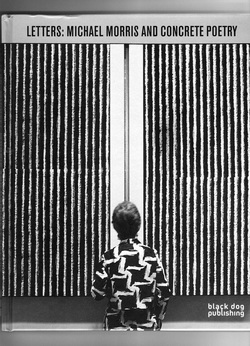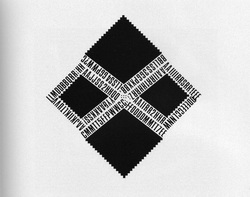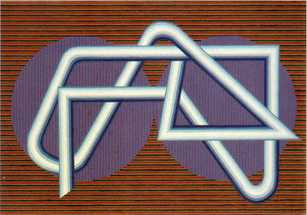
This impressively produced survey of the early work of Vancouver painter, conceptual artist, performance artist, and concrete poet Michael Morris, together with a presentation of Canadian concrete poetry of the 1960s and 70s and its international context was “published to accompany the exhibition” Letters: Michael Morris and Concrete Poetry in 2012 at the University of British Columbia’s Belkin Art Gallery, but not published by the UK’s Black Dog Publishing until late in 2015. The Belkin appears to be the book’s co-publisher and Canadian distributor, although the book is copyrighted only to Black Dog.
 Untitled concrete poem by Morris, 1967. Letters, 105.
Untitled concrete poem by Morris, 1967. Letters, 105. The three essays that accompany the reproductions of Morris’s paintings and sculpture – essays by David McWilliam, William Wood, and Scott Watson – map its development and place and locate it informatively within the context of the art then emerging in Europe and North America. They also relate it usefully to his creative and curatorial projects in mail art and concrete poetry. The two essays that accompany the concrete poetry – Jamie Hilder’s “Concrete Poetry: from The Procedural to the Performative,” and Michael Turner’s “Visual Poems: Imaginary Museums,” are
 Untitled gouache on paper by Morris, 1966. Letters, 20.
Untitled gouache on paper by Morris, 1966. Letters, 20. Turner appears most interested in developing a mostly irrelevant contrast between bill bissett’s blue ointment magazine and the 1960s poetry newsletter TISH, and between the visual art milieu in which bissett, Morris, and other Vancouver artists such as Nichol, Judith Copithorne, or Gerry Gilbert worked, and the more academic milieu of the five 1961-63 TISH poet-editors (he ignores the potentially complicating 25 TISH issues of 1963-69 produced by different editorial collectives). From this contrast he posits further binaries – “literary” poet-editors versus “filmic” and “collagist” visual artists (127); “academic” and “institutional” poets versus artists committed to “networks of artistic interaction and exchange” (125); poets who tie their work and careers to “central” Canadian academic institutions versus visual artists who are “constellational.” He writes “despite their ambivalence toward an ‘official’ national literature the TISH poets ‘acted’ as if there were ‘a use for centre’ (central Canada was where the teaching positions were), while Vancouver’s sound and concrete poets, and Nichol, were constellational...”(125).
In fact only one of the five TISH poet-editors he is referring to taught for a significant length of time in central Canada (I won’t tell you who that was); three of the five never did, and one of those never taught. In 1968 the fourth of these TISH-eds, George Bowering, published the collagist long poem Rocky Mountain Foot and in 1971 the procedural long poem Genève. Go figure – or go re-figure.
Turner specifically includes Nichol among those artists who declined the academy “as a site in which to conduct research and provide instruction” (125), apparently unaware that Nichol taught Creative Writing from 1982-88 at Toronto’s York University, and did extensive personal research into the Dadaists and Freudian psychology while working 1965-68 at the University of Toronto’s Sigmund Samuel Library.
It’s unfortunate for this otherwise reliable and attractive book that Turner has framed his comments on Morris this way. He clearly knows much more about Morris and his work than he knows about TISH, or even about Nichol. He amusingly awards Nichol “a Bachelor of Arts degree at UBC where he studied under Earle Birney” (135) despite Nichol having spent only one year at UBC (1962-63), in the Faculty of Education rather than Arts, and Birney that year having been travelling in Mexico and Europe, on a Canada Council-financed leave. Morris himself at the time of his early breakout exhibitions had the benefit of as much academic/institutional education as most of the TISH editors had in 1961 when launching that newsletter. He had studied at the University of Victoria 1960-61, at the Vancouver School of Art 1962-64, and at University College London’s Slade School of Fine Art 1965-66.
Anyway, this is a beautifully done book about a major Canadian artist who is little known in the general culture although well-known in the Canadian art community – even in central Canada – since the late 1960s. It has multi-page colour reproductions of Morris's eight institutional-scale Letters series, not exhibited together until the Belkin's 2012 show. It also offers in colour fine portfolios of concrete poems from the 1960s by Morris and by numerous others who were included in the 1969 exhibition Concrete Poetry: An Exhibition in Four Parts which Morris co-curated with Alvin Balkind for the UBC Fine Arts Gallery.
FD
 RSS Feed
RSS Feed